《物质安全数据表》安全用语英汉对照版
MSDS(中英文对照)
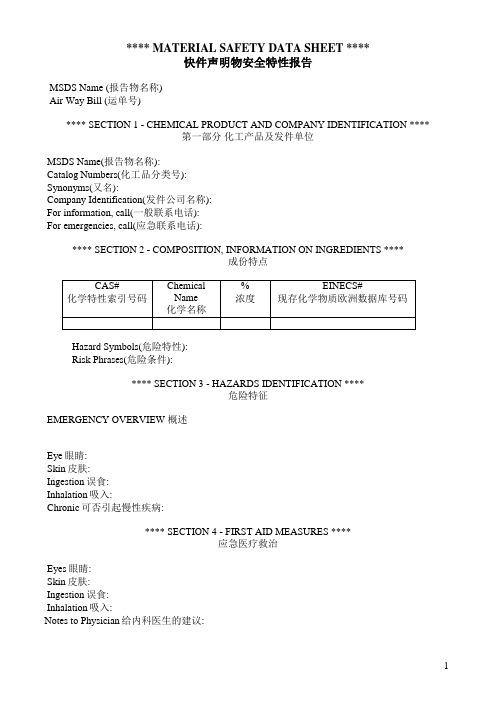
**** MATERIAL SAFETY DATA SHEET ****快件声明物安全特性报告MSDS Name (报告物名称)Air Way Bill (运单号)**** SECTION 1 - CHEMICAL PRODUCT AND COMPANY IDENTIFICATION ****第一部分化工产品及发件单位MSDS Name(报告物名称):Catalog Numbers(化工品分类号):Synonyms(又名):Company Identification(发件公司名称):For information, call(一般联系电话):For emergencies, call(应急联系电话):**** SECTION 2 - COMPOSITION, INFORMATION ON INGREDIENTS ****成份特点Hazard Symbols(危险特性):Risk Phrases(危险条件):**** SECTION 3 - HAZARDS IDENTIFICATION ****危险特征EMERGENCY OVERVIEW 概述Eye眼睛:Skin皮肤:Ingestion误食:Inhalation吸入:Chronic可否引起慢性疾病:**** SECTION 4 - FIRST AID MEASURES ****应急医疗救治Eyes眼睛:Skin皮肤:Ingestion误食:Inhalation吸入:Notes to Physician给内科医生的建议:**** SECTION 5 - FIRE FIGHTING MEASURES ****消防扑救方法**** SECTION 6 - ACCIDENTAL RELEASE MEASURES ****事故处理General Information:一般信息:Spills/Leaks泄露/溢出:.**** SECTION 7 - HANDLING and STORAGE ****处理和存放Handling处理:Storage存储:**** SECTION 8 - EXPOSURE CONTROLS, PERSONAL PROTECTION ****安全控制和人员保护Engineering Controls机械控制:Personal Protective Equipment个人防护**** SECTION 9 - PHYSICAL AND CHEMICAL PROPERTIES ****Physical State(物理状态): Color(颜色):Odor(味道): pH:Vapor Pressure(蒸汽压力): Viscosity(黏度): Boiling Point(沸点): Freezing/Melting Point(冰点): Autoignition Temperature(自燃温度): Flash Point(闪点):Explosion Limits, lower(爆炸极限,低): Explosion Limits, upper(爆炸极限,高):Decomposition Temperature(分解温度): Solubility in water(溶解度): Specific Gravity/Density(特定浓度): Molecular Formula(分子式): Molecular Weight(分子重量):**** SECTION 10 - STABILITY AND REACTIVITY ****稳定性和活性Chemical Stability化学稳定性:Conditions to Avoid: 应避免的环境**** SECTION 11 - TOXICOLOGICAL INFORMATION ****毒性信息RTECS#(毒性数据号码):**** SECTION 12 - ECOLOGICAL INFORMATION ****生态学信息**** SECTION 13 - DISPOSAL CONSIDERATIONS ****销毁建议**** SECTION 14 - TRANSPORT INFORMATION ****空运信息Reported by: (报告人)Company Name : _______________________ Date: ____________________公司名称:日期:Authorized Person: _________________ Signature: ______________________ 报告人签名:。
In52Sn48无铅锡条物质安全资料表MSDS(中英对照)
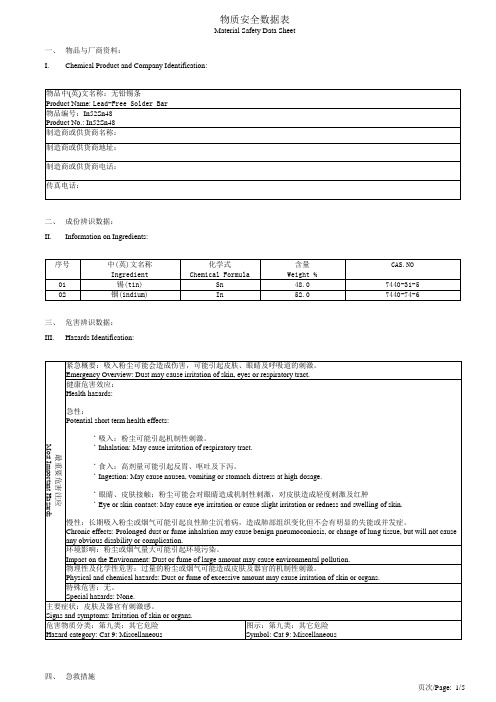
一、物品与厂商资料:I. Chemical Product and Company Identification:二、成份辨识数据:II. Information on Ingredients:三、危害辨识数据:III. Hazards Identification:四、急救措施IV. First Aid Measures五、灭火措施:该产品属于不燃物质V. Fire-fighting Measures: Not flammable.六、泄露处理方法:VI. Accidental Release Measures:七、安全处置与储存方法:VII. Handling and Storage:八、曝露预防措施:VIII. Exposure Controls/Personal Protection:九、物理及化学数据:IX. Physical & Chemical Properties:十、安定性及反应性:X. Chemical Stability & Reactivity Information:十一、毒性资料:本项无相关资料可查。
XI. Toxicological Information: No relative information.十二、生态资料:本项无相关资料可查。
XII. Ecological Information: No relative information.十三、废气处理方法:本项不适用。
XIII. Waste Gas Disposal Considerations: N/A.十四、运送资料:XIV. Transport Information:十五、适用法规:XV. Regulatory Information:十六、其它数据:XVI. Other Information:本表仅供参考,运作人需自行必要的处理。
This sheet is only for information. The operator shall take the responsibility.。
Bi50Pb25Sn25有铅锡条物质安全数据表MSDS(中英对照)
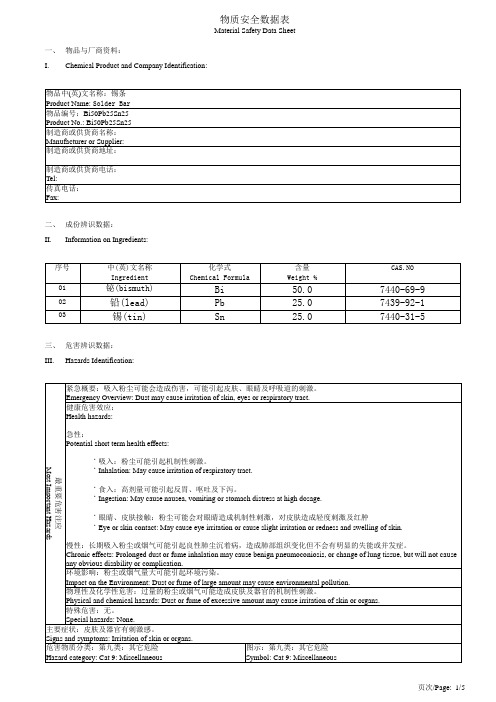
一、物品与厂商资料:I. Chemical Product and Company Identification:二、成份辨识数据:II. Information on Ingredients:三、危害辨识数据:III. Hazards Identification:四、急救措施IV. First Aid Measures五、灭火措施:该产品属于不燃物质V. Fire-fighting Measures: Not flammable.六、泄露处理方法:VI. Accidental Release Measures:七、安全处置与储存方法:VII. Handling and Storage:八、曝露预防措施:VIII. Exposure Controls/Personal Protection:九、物理及化学数据:IX. Physical & Chemical Properties:十、安定性及反应性:X. Chemical Stability & Reactivity Information:十一、毒性资料:本项无相关资料可查。
XI. Toxicological Information: No relative information.十二、生态资料:本项无相关资料可查。
XII. Ecological Information: No relative information.十三、废气处理方法:本项不适用。
XIII. Waste Gas Disposal Considerations: N/A.十四、运送资料:XIV. Transport Information:十五、适用法规:XV. Regulatory Information:十六、其它数据:XVI. Other Information:本表仅供参考,运作人需自行必要的处理。
This sheet is only for information. The operator shall take the responsibility.。
物料安全数据表(英文版)

MATERIAL SAFETY DATA SHEETGasoline, Premium Unleaded MSDS No. 0324 1. CHEMICAL PRODUCT and COMPANY INFORMATION (rev. Dec-97)Amerada Hess Corporation1 Hess PlazaWoodbridge, NJ 07095-0961EMERGENCY TELEPHONE NUMBER (24 hrs): CHEMTREC (800) 424-9300COMPANY CONTACT (business hours): Corporate Safety (732) 750-6000 SYNONYMS:93 Octane Conventional (Oxygenated and Non-oxygenated) and Reformulated (RFG) Premium Unleaded GasolineSee Section 16 for abbreviations and acronyms.POSITION and INFORMATION ON INGREDIENTS *(rev. Dec-97)INGREDIENT NAME*EXPOSURE LIMITSCONCENTRATION PERCENT BY WEIGHTGasolineCAS NUMBER: 8006-61-9OSHA PEL-TWA/STEL: None establishedACGIH TLV-TWA/STEL: 300 / 500 ppm, A3100BenzeneCAS NUMBER: 71-43-2OSHA PEL-TWA/STEL: 1 / 5 ppmACGIH TLV-TWA: 0.5 / 2.5 ppm, A1, skinUS Coast Guard:same as OSHA0.1 to 4.90.1 to 1.3**for reformulatedgasolineMethyl-tertiary butyl ether (MTBE) CAS NUMBER: 1634-04-4OSHA PEL-TWA/STEL: None establishedACGIH TLV-TWA:40 ppm, A30 to 15.0Tertiary-amyl methyl ether (TAME)CAS NUMBER: 994-05-8None established0 to 17.2TolueneCAS NUMBER: 108-88-3OSHA PEL-TWA/Ceiling:200 / 300 ppmOSHA PEL-Peak:500 ppm (10 min.)ACGIH TLV-TWA: 50 ppm, A4 (skin)1 - 25Xylene, mixed isomersCAS NUMBER: 1330-20-7OSHA PEL-TWA: 100 ppmACGIH TLV-TWA/STEL: 100 / 150 ppm, A41 - 15A complex blend of petroleum-derived normal and branched-chain alkane, cycloalkane, alkene, andaromatic hydrocarbons. Butane is often added to increase volatility, especially in winter. May contain antioxidant and multifunctional additives. Oxygenated and reformulated gasoline will have legally-required amounts of oxygenates (MTBE and/or TAME).*Also see Section 15 for list of SARA Section 313 toxic chemicals and their exposure limits.3.HAZARDS IDENTIFICATION(rev. Dec-97; Tox-97)EMERGENCY OVERVIEWDANGER!EXTREMELY FLAMMABLE - EYE AND MUCOUS MEMBRANE IRRITANT - EFFECTS CENTRAL NERVOUS SYSTEM - HARMFUL OR FATAL IF SWALLOWED - ASPIRATION HAZARDHigh fire hazard. Keep away from heat, spark, open flame, and other ignition sources.If ingested, do NOT induce vomiting, as this may cause chemical pneumonia (fluid in the lungs). Contactmay cause eye, skin and mucous membrane irritation. Harmful if absorbed through the skin. Avoidprolonged breathing of vapors or mists. Inhalation may cause irritation, anesthetic effects (dizziness, nausea, headache, intoxication), and respiratory system effects.Long-term exposure may cause effects to specific organs, such as to the liver, kidneys, blood, nervous system, and skin. Contains benzene, which can cause blood disease, including anemia and leukemia.NFPA 704 (Section 16)Gasoline, Premium Unleaded MSDS No. 0324 EYESModerate irritant. Contact with liquid or vapor may cause irritation.SKINModerate irritant. May cause skin irritation with prolonged or repeated contact. Practically non-toxic if absorbed following acute (single) exposure. Liquid may be absorbed through the skin in toxic amounts if large areas of skin are exposed repeatedly.INGESTIONThe major health threat of ingestion occurs from the danger of aspiration (breathing) of liquid drops into the lungs, particularly from vomiting. Aspiration may result in chemical pneumonia (fluid in the lungs), severe lung damage, respiratory failure and even death.Ingestion may cause gastrointestinal disturbances, including irritation, nausea, vomiting and diarrhea, and central nervous system (brain) effects similar to alcohol intoxication. In severe cases, tremors, convulsions, loss of consciousness, coma, respiratory arrest, and death may occur.INHALATIONExcessive exposure may cause irritations to the nose, throat, lungs and respiratory tract. Central nervous system (brain) effects may include headache, dizziness, loss of balance and coordination, unconsciousness, coma, respiratory failure, and death.WARNING: the burning of any hydrocarbon as a fuel in an area without adequate ventilation may result in hazardous levels of combustion products, including carbon monoxide, and inadequate oxygen levels, which may cause unconsciousness, suffocation, and death.CHRONIC EFFECTS and CARCINOGENICITYContains benzene, a regulated human carcinogen. Benzene has the potential to cause anemia and other blood diseases, including leukemia, after repeated and prolonged exposure. Exposure to light hydrocarbons in the same boiling range as this product has been associated in animal studies with systemic toxicity. See also Section 11 - Toxicological Information.MEDICAL CONDITIONS AGGRAVATED BY EXPOSUREIrritation from skin exposure may aggravate existing open wounds, skin disorders, and dermatitis (rash). Chronic respiratory disease, liver or kidney dysfunction, or pre-existing central nervous system disorders may be aggravated by exposure.4.FIRST AID MEASURES(rev. Dec-97; Tox-97)EYESIn case of contact with eyes, immediately flush with clean, low-pressure water for at least 15 min. Hold eyelids open to ensure adequate flushing. Seek medical attention.SKINRemove contaminated clothing. Wash contaminated areas thoroughly with soap and water or waterless hand cleanser. Obtain medical attention if irritation or redness develops.INGESTIONDO NOT INDUCE VOMITING. Do not give liquids. Obtain immediate medical attention. If spontaneous vomiting occurs, lean victim forward to reduce the risk of aspiration. Small amounts of material which enter the mouth should be rinsed out until the taste is dissipated.INHALATIONRemove person to fresh air. If person is not breathing, ensure an open airway and provide artificial respiration. If necessary, provide additional oxygen once breathing is restored if trained to do so. Seek medical attention immediately.Gasoline, Premium Unleaded MSDS No. 0324 5.FIRE FIGHTING MEASURES(rev. Dec-97)FLAMMABLE PROPERTIES:FLASH POINT:-45 o F (-43o C)AUTOIGNITION TEMPERATURE:highly variable; > 530 o F (>280 o C)OSHA/NFPA FLAMMABILITY CLASS:1A (flammable liquid)LOWER EXPLOSIVE LIMIT (%): 1.4%UPPER EXPLOSIVE LIMIT (%):7.6%FIRE AND EXPLOSION HAZARDSVapors may be ignited rapidly when exposed to heat, spark, open flame or other source of ignition. Flowing product may be ignited by self-generated static electricity. When mixed with air and exposed to an ignition source, flammable vapors can burn in the open or explode in confined spaces. Being heavier than air, vapors may travel long distances to an ignition source and flash back. Runoff to sewer may cause fire or explosion hazard.EXTINGUISHING MEDIASMALL FIRES: Any extinguisher suitable for Class B fires, dry chemical, CO2, water spray, fire fighting foam, or Halon.LARGE FIRES: Water spray, fog or fire fighting foam. Water may be ineffective for fighting the fire, but may be used to cool fire-exposed containers.During certain times of the year and/or in certain geographical locations, gasoline may contain MTBEand/or TAME. Firefighting foam suitable for polar solvents is recommended for fuel with greater than 10% oxygenate concentration - refer to NFPA 11 “Low Expansion Foam - 1994 Edition.”FIRE FIGHTING INSTRUCTIONSSmall fires in the incipient (beginning) stage may typically be extinguished using handheld portable fire extinguishers and other fire fighting equipment.Firefighting activities that may result in potential exposure to high heat, smoke or toxic by-products of combustion should require NIOSH/MSHA- approved pressure-demand self-contained breathing apparatus with full facepiece and full protective clothing.Isolate area around container involved in fire. Cool tanks, shells, and containers exposed to fire and excessive heat with water. For massive fires the use of unmanned hose holders or monitor nozzles may be advantageous to further minimize personnel exposure. Major fires may require withdrawal, allowing the tank to burn. Large storage tank fires typically require specially trained personnel and equipment to extinguish the fire, often including the need for properly applied fire fighting foam.See Section 16 for the NFPA 704 Hazard Rating.6.ACCIDENTAL RELEASE MEASURES(rev. Dec-97)ACTIVATE FACILITY SPILL CONTINGENCY or EMERGENCY PLAN.Evacuate nonessential personnel and remove or secure all ignition sources. Consider wind direction; stay upwind and uphill, if possible. Evaluate the direction of product travel, diking, sewers, etc. to confirm spill areas. Spills may infiltrate subsurface soil and groundwater; professional assistance may be necessary to determine the extent of subsurface impact.Carefully contain and stop the source of the spill, if safe to do so. Protect bodies of water by diking, absorbents, or absorbent boom, if possible. Do not flush down sewer or drainage systems, unless system is designed and permitted to handle such material. The use of fire fighting foam may be useful in certain situations to reduce vapors. The proper use of water spray may effectively disperse product vapors or the liquid itself, preventing contact with ignition sources or areas/equipment that require protection.Take up with sand or other oil absorbing materials. Carefully shovel, scoop or sweep up into a waste container for reclamation or disposal - caution, flammable vapors may accumulate in closed containers.Gasoline, Premium Unleaded MSDS No. 0324 Response and clean-up crews must be properly trained and must utilize proper protective equipment (see Section 8).7.HANDLING and STORAGE(rev. Dec-97)HANDLING PRECAUTIONS******USE ONLY AS A MOTOR FUEL************DO NOT SIPHON BY MOUTH******Handle as a flammable liquid. Keep away from heat, sparks, and open flame! Electrical equipment should be approved for classified area. Bond and ground containers during product transfer to reduce the possibility of static-initiated fire or explosion.Special slow load procedures for "switch loading" must be followed to avoid the static ignition hazard that can exist when higher flash point material (such as fuel oil) is loaded into tanks previously containing low flash point products (such as this product) - see API Publication 2003, "Protection Against Ignitions Arising Out Of Static, Lightning and Stray Currents.STORAGE PRECAUTIONSKeep away from flame, sparks, excessive temperatures and open flame. Use approved vented containers. Keep containers closed and clearly labeled. Empty product containers or vessels may contain explosive vapors. Do not pressurize, cut, heat, weld or expose such containers to sources of ignition. Store in a well-ventilated area. This storage area should comply with NFPA 30 "Flammable and Combustible Liquid Code". Avoid storage near incompatible materials. The cleaning of tanks previously containing this product should follow API Recommended Practice (RP) 2013 "Cleaning Mobile Tanks In Flammable and Combustible Liquid Service" and API RP 2015 "Cleaning Petroleum Storage Tanks". WORK/HYGIENIC PRACTICESEmergency eye wash capability should be available in the near proximity to operations presenting a potential splash exposure. Use good personal hygiene practices. Avoid repeated and/or prolonged skin exposure. Wash hands before eating, drinking, smoking, or using toilet facilities. Do not use as a cleaning solvent on the skin. Do not use solvents or harsh abrasive skin cleaners for washing this product from exposed skin areas. Waterless hand cleaners are effective. Promptly remove contaminated clothing and launder before reuse. Use care when laundering to prevent the formation of flammable vapors which could ignite via washer or dryer. Consider the need to discard contaminated leather shoes and gloves.8.EXPOSURE CONTROLS and PERSONAL PROTECTION(rev. Dec-97)ENGINEERING CONTROLSUse adequate ventilation to keep vapor concentrations of this product below occupational exposure and flammability limits, particularly in confined spaces.EYE/FACE PROTECTIONSafety glasses or goggles are recommended where there is a possibility of splashing or spraying.SKIN PROTECTIONGloves constructed of nitrile or neoprene are recommended. Chemical protective clothing such as of E.I. DuPont Tychem ®, Barricade ®, or equivalent recommended based on degree of exposure.Note: The resistance of specific material may vary from product to product as well as with degree of exposure. Consult manufacturer specifications for further information.RESPIRATORY PROTECTIONA NIOSH/MSHA-approved air-purifying respirator with organic vapor cartridges or canister may be permissible under certain circumstances where airborne concentrations are or may be expected to exceed exposure limits or for odor or irritation. Protection provided by air-purifying respirators is limited. Refer to OSHA 29 CFR 1910.134, ANSI Z88.2-1992, NIOSH Respirator Decision Logic, and the manufacturer for additional guidance on respiratory protection selection and limitations.Gasoline, Premium Unleaded MSDS No. 0324 Use a positive pressure, air-supplied respirator if there is a potential for uncontrolled release, exposure levels are not known, in oxygen-deficient atmospheres, or any other circumstance where an air-purifying respirator may not provide adequate protection.9.PHYSICAL and CHEMICAL PROPERTIES(rev. Dec-94)APPEARANCEA clear, water-like liquidODORA strong, characteristic aromatic hydrocarbon odor. Oxygenated gasoline with MTBE and/or TAME may have a sweet, ether-like odor and is detectable at a lower concentration than non-oxygenated gasoline. ODOR THRESHOLDOdor Detection Odor RecognitionNon-oxygenated gasoline:0.5 - 0.6 ppm0.8 - 1.1 ppmGasoline with 15% MTBE:0.2 - 0.3 ppm0.4 - 0.7 ppmGasoline with 15% TAME:0.1 ppm0.2 ppmBASIC PHYSICAL PROPERTIESBOILING RANGE:85 to 437 o F(39 to 200 o C)VAPOR PRESSURE:7 - 15 RVP @ 100 o F (38 o C) (275-475 mm Hg @ 68 o F (20 o C) VAPOR DENSITY (air = 1):AP 3 to 4SPECIFIC GRAVITY (H2O = 1):0.76EVAPORATION RATE:10-11 (n-butyl acetate = 1)PERCENT VOLATILES:100 %SOLUBILITY (H2O):Non-oxygenated gasoline - negligible (< 0.1% @ 77 o F). Gasoline with15% MTBE - slight (0.1 - 3% @ 77 o F)10.STABILITY and REACTIVITY(rev. Dec-94)STABILITY:Stable. Hazardous polymerization will not occur.CONDITIONS TO AVOIDAvoid high temperatures, open flames, sparks, welding, smoking and other ignition sources INCOMPATIBLE MATERIALSKeep away from strong oxidizers.HAZARDOUS DECOMPOSITION PRODUCTSCarbon monoxide, carbon dioxide and non-combusted hydrocarbons (smoke). Contact with nitric and sulfuric acids will form nitrocresols that can decompose violently.11.TOXICOLOGICAL PROPERTIES(rev. Dec-97; Tox-97)ACUTE TOXICITYAcute Dermal LD50 (rabbits): > 5 ml/kg Acute Oral LD50 (rat): 18.75 ml/kgPrimary dermal irritation (rabbits): slightly irritating Draize eye irritation (rabbits): non-irritating Guinea pig sensitization: negativeCHRONIC EFFECTS AND CARCINOGENICITYCarcinogenicity: OSHA: NO IARC: YES - 2B NTP: NO ACGIH: YES (A3)IARC has determined that gasoline and gasoline exhaust are possibly carcinogenic in humans. Inhalation exposure to completely vaporized unleaded gasoline caused kidney cancers in male rats and liver tumors in female mice. The U.S. EPA has determined that the male kidney tumors are species-specific and are irrelevant for human health risk assessment. The significance of the tumors seen in female mice is not known. Exposure to light hydrocarbons in the same boiling range as this product has been associated in animal studies with effects to the central and peripheral nervous systems, liver, and kidneys. The significance of these animal models to predict similar human response to gasoline is uncertain.Gasoline, Premium Unleaded MSDS No. 0324 This product contains benzene. Human health studies indicate that prolonged and/or repeated overexposure to benzene may cause damage to the blood-forming system (particularly bone marrow), and serious blood disorders such as aplastic anemia and leukemia. Benzene is listed as a human carcinogen by the NTP, IARC, OSHA and ACGIH.This product may contain methyl tertiary butyl ether (MTBE ): animal and human health effects studies indicate that MTBE may cause eye, skin, and respiratory tract irritation, central nervous system depression and neurotoxicity. MTBE is classified as an animal carcinogen (A3) by the ACGIH.12.ECOLOGICAL INFORMATION(rev. Dec-97)Keep out of sewers, drainage areas and waterways. Report spills and releases, as applicable, under Federal and State regulations.13.DISPOSAL CONSIDERATIONS(rev. Dec-97)Consult federal, state and local waste regulations to determine appropriate disposal options.14.TRANSPORTATION INFORMATION(rev. Dec-97)DOT PROPER SHIPPING NAME:GasolineDOT HAZARD CLASS & PACKING GROUP:3, PG IIDOT IDENTIFICATION NUMBER:UN 1203DOT SHIPPING LABEL:FLAMMABLE LIQUID15.REGULATORY INFORMATION(rev. Dec-97)U.S. FEDERAL, STATE, and LOCAL REGULATORY INFORMATIONThis product and its constituents listed herein are on the EPA TSCA Inventory. Any spill or uncontrolled release of this product, including any substantial threat of release, may be subject to federal, state and/or local reporting requirements. This product and/or its constituents may also be subject to other federal, state, or local regulations; consult those regulations applicable to your facility/operation.CLEAN WATER ACT (OIL SPILLS)Any spill or release of this product to "navigable waters" (essentially any surface water, including certain wetlands) or adjoining shorelines sufficient to cause a visible sheen or deposit of a sludge or emulsion must be reported immediately to the National Response Center (1-800-424-8802) or, if not practical, the U.S. Coast Guard with follow-up to the National Response Center, as required by U.S. Federal Law. Also contact appropriate state and local regulatory agencies as required.CERCLA SECTION 103 and SARA SECTION 304 (RELEASE TO THE ENVIRONMENT)The CERCLA definition of hazardous substances contains a “petroleum exclusion” clause which exempts crude oil, refined, and unrefined petroleum products and any indigenous components of such. However, other federal reporting requirements (e.g., SARA Section 304 as well as the Clean Water Act if the spill occurs on navigable waters) may still apply.SARA SECTION 311/312 - HAZARD CLASSESACUTE HEALTH CHRONIC HEALTH FIRE SUDDEN RELEASE OF PRESSURE REACTIVE X X X----SARA SECTION 313 - SUPPLIER NOTIFICATIONThis product contains the following toxic chemicals subject to the reporting requirements of section 313 of the Emergency Planning and Community Right-To-Know Act (EPCRA) of 1986 and of 40 CFR 372:INGREDIENT NAME (CAS NUMBER)CONCENTRATIONWT. PERCENT EXPOSURE LIMITSBenzene (71-43-2)0.1 to 4.9See Section 2Benzene (71-43-2) for reformulated gasoline0.1 to 1.3*See Section 2Ethyl benzene (100-41-4)< 3OSHA PEL-TWA: 100 ppmACGIH TLV-TWA/STEL: 100 / 125 ppmGasoline, Premium Unleaded MSDS No. 0324INGREDIENT NAME (CAS NUMBER)CONCENTRATIONWT. PERCENT EXPOSURE LIMITSn-Hexane (110-54-3)0.5 to 4OSHA PEL-TWA: 500 ppmACGIH TLV-TWA: 50 ppm Methyl-tertiary butyl ether (MTBE) (1634-04-4)0 to 15.0See Section 2Toluene (108-88-3) 1 to 25See Section 21,2,4- Trimethylbenzene (95-63-6)< 6OSHA PEL-TWA/STEL: 25 ppmACGIH TLV-TWA/STEL: 25 ppm Xylene, mixed isomers (1330-20-7) 1 to 15See Section 2CANADIAN REGULATORY INFORMATION (WHMIS)Class B, Division 2 (Flammable Liquid)Class D, Division 2A (Very toxic by other means) and Class D, Division 2B (Toxic by other means) 16.OTHER INFORMATION (rev. Dec-97)NFPA® HAZARD RATING HEALTH:1SlightFIRE:3SeriousREACTIVITY:0MinimalHMIS® HAZARD RATING HEALTH: 1 *SlightFIRE:3SeriousREACTIVITY:0Minimal* CHRONICSUPERSEDES MSDS DATED:9/16/96ABBREVIATIONS:AP = Approximately< = Less than > = Greater thanN/A = Not Applicable N/D = Not Determined ppm = parts per millionACRONYMS:ACGIH American Conference of Governmental Industrial HygienistsAIHA American Industrial Hygiene Association ANSI American National Standards Institute(212)642-4900API American Petroleum Institute(202)682-8000CERCLA Comprehensive Emergency Response, Compensation, and Liability ActDOT U.S. Department of Transportation[General Info: (800)467-4922]EPA U.S. Environmental Protection Agency HMIS Hazardous Materials Information System IARC International Agency For Research On CancerMSHA Mine Safety and Health Administration NFPA National Fire Protection Association(617)770-3000NIOSH National Institute of Occupational Safety and HealthNOIC Notice of Intended Change (proposedchange to ACGIH TLV)NTP National Toxicology ProgramOPA Oil Pollution Act of 1990OSHA U.S. Occupational Safety & HealthAdministrationPEL Permissible Exposure Limit (OSHA) RCRA Resource Conservation and Recovery Act REL Recommended Exposure Limit (NIOSH) SARA Superfund Amendments andReauthorization Act of 1986 Title III SCBA Self-Contained Breathing Apparatus SPCC Spill Prevention, Control, andCountermeasuresSTEL Short-Term Exposure Limit (generally 15 minutes)TLV Threshold Limit Value (ACGIH)TSCA Toxic Substances Control ActTWA Time Weighted Average (8 hr.)WEEL Workplace Environmental ExposureLevel (AIHA)WHMIS Workplace Hazardous MaterialsInformation System (Canada)MATERIAL SAFETY DATA SHEETGasoline, Premium Unleaded MSDS No. 0324 DISCLAIMER OF EXPRESSED AND IMPLIED WARRANTIESInformation presented herein has been compiled from sources considered to be dependable, and is accurate and reliable to the best of our knowledge and belief, but is not guaranteed to be so. Since conditions of use are beyond our control, we make no warranties, expressed or implied, except those that may be contained in our written contract of sale or acknowledgment.Vendor assumes no responsibility for injury to vendee or third persons proximately caused by the material if reasonable safety procedures are not adhered to as stipulated in the data sheet. Additionally, vendor assumes no responsibility for injury to vendee or third persons proximately caused by abnormal use of the material, even if reasonable safety procedures are followed. Furthermore, vendee assumes the risk in their use of the material.。
安全术语 中英文对照1
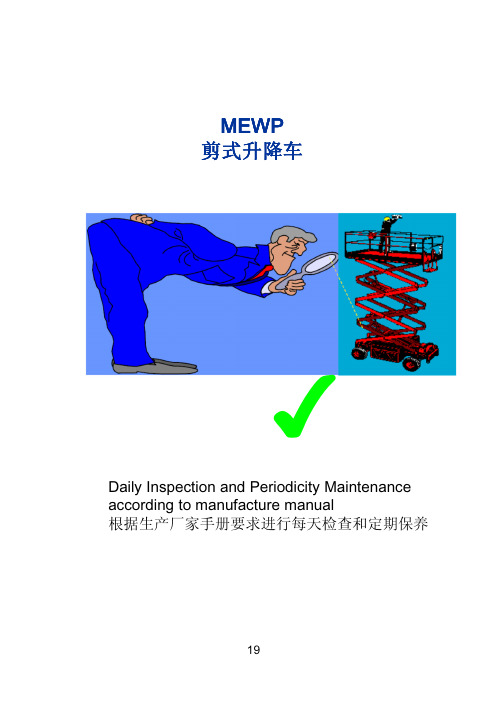
MEWP剪式升降车✔Daily Inspection and Periodicity Maintenance according to manufacture manual根据生产厂家手册要求进行每天检查和定期保养19WELDING SAFETY焊接安全✔Ensure are equipment,properties, machinery and unremovable flammable materials are covered with fire blankets before any welding to be carried out.在电焊工作开始之前,确保周围的设备/机器/管道/以及不可移动的易燃材料已被受到防火保护。
20WELDING SAFETY焊接安全Ensure no flammable materials are present nearby when welding. 电焊时确保周围无易燃物存在。
21✘MACHINERY/EQUIPMENT SAFETY机械/设备安全Do not overload your equipment/machinery. Only authorised personnel are allowed to operate heavy machinery and equipment.不要超载。
只有经授权的人员才可操作重型机械/设备。
22✘MACHINERY/EQUIPMENT SAFETY机械/设备安全✘Concentrate when operatingmachinery e.g excavator,cranes and bulldozer.操作时集中注意力!Lack concentration will resultsin undesirable incidents.注意力不集中导致事故。
23MACHINERY/EQUIPMENT SAFETY机械/设备安全✘Ensure that the load is secured before moving it.移动前确保运输物已被固定。
MATERIAL SAFETY DATA SHEET样本翻译
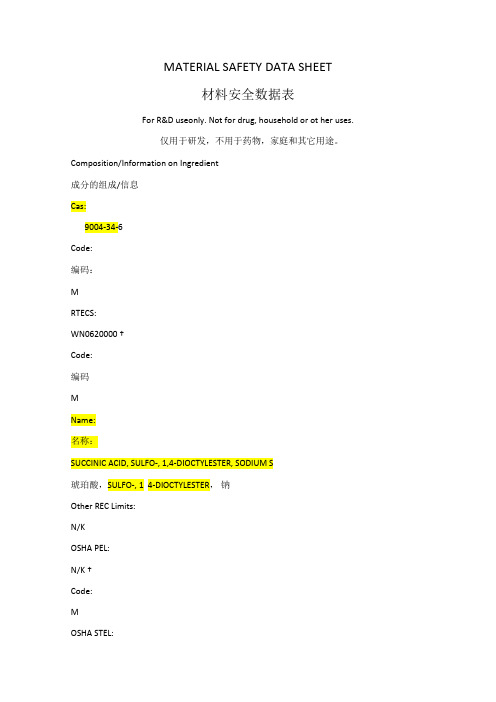
MATERIAL SAFETY DATA SHEET材料安全数据表For R&D useonly. Not for drug, household or ot her uses.仅用于研发,不用于药物,家庭和其它用途。
Composition/Information on Ingredient成分的组成/信息Cas:9004-34-6Code:编码:MRTECS:WN0620000 †Code:编码MName:名称:SUCCINIC ACID, SULFO-, 1,4-DIOCTYLESTER, SODIUM S琥珀酸,SULFO-, 1 4-DIOCTYLESTER,钠Other REC Limits:N/KOSHA PEL:N/K †Code:MOSHA STEL:Code:ACGIH TLV:N/K †Code:MACGIHSTEL:N/P †Code:Control Measures控制方法Respiratory Protection:呼吸系统防护:WEAR NIOSH APPROVED OR EQUIVALENT RESPIRATOR. FOR LARGE SPILLS, ENTRY INTO LARGETANKS, VESSELS OR ENCLOSED SMALL SPACES W/INADEQUATE VENTILATION, A PRESSURE-DEMAND, SELF-CONTAINED BREATHING APPARATUS IS RECOMMENDED.穿戴NIOSH批准的或相同的呼吸器。
在大量溢出的情况下,进入通风不足的地方如大的油罐,管道或密闭的小空间,推荐使用自给式呼吸器装置。
Ventilation:通风:PROVIDE GENERAL VENTILATION提供一般的通风Protective Gloves:防护手套:IMPERMEABLE不透水Eye Protection:眼睛保护:CHEMICAL SPLASH GOGGLESOther Protective Equipment:其它保护设备:Equipment N/K设备N / KWork Hygienic Practices:工作的卫生习惯REMOVE/LAUNDER CONTAMINATED CLOTHING BEFORE REUSE.再次使用前脱下并清洗受污染的衣物。
MSDS翻译--材料安全数据表翻译

材料安全数据表翻译MSDS翻译案例:英翻中MSDS (Material Safety Data Sheet) 化学品安全数据说明书,里面会包含有接触后的急救措施、燃爆性与消防措施、成分与组成、泄漏应急处理、搬运与储存、物理特性、环保措施、健康危害等一些信息的。
本文是一则从英语翻译到中文的MSDS翻译案例。
更多翻译案例请访问:/our-case/2013-4-15为保护客户隐私,仅截取部分:Emergency overview紧急概述Milky white emulsion. Avoid inhaling mist. Avoid contact with eyes and skin.乳白乳液。
避免吸入雾液。
避免眼睛和皮肤接触。
Ethylene-vinylchloride-vinylacetate copolymer乙烯-氯乙烯-醋酸乙烯共聚物First aid procedures急救程序Inhalation吸入Remove to fresh air. Give the victim rest. If not breathing, give artificial respiration. If breathing is difficult, give oxygen. Never give anything by mouth to an unconscious person. Get immediate medical attention.转移到空气新鲜的地方。
让受害人休息。
若不能呼吸,进行人工呼吸。
若呼吸困难,输氧。
勿给失去知觉的人口服任何东西。
立即就医。
Eye contact不慎入眼Immediately hold eyelids apart and flush eyes with plenty of water for at least 15 minutes. Get medical attention. Remove contact lenses if worn.立即撑开眼睑,用大量的水冲洗眼睛至少15分钟并就医。
Risk Codes安全术语中英文对照
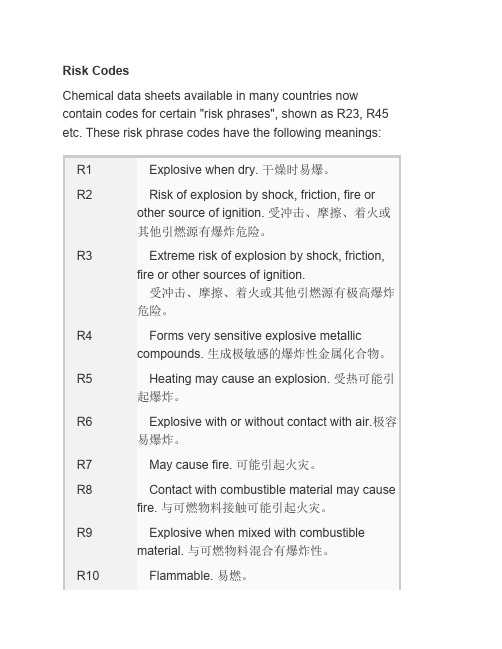
Risk CodesChemical data sheets available in many countries now contain codes for certain "risk phrases", shown as R23, R45 etc. These risk phrase codes have the following meanings: R1 Explosive when dry. 干燥时易爆。
R2 Risk of explosion by shock, friction, fire orother source of ignition. 受冲击、摩擦、着火或其他引燃源有爆炸危险。
R3 Extreme risk of explosion by shock, friction,fire or other sources of ignition. 受冲击、摩擦、着火或其他引燃源有极高爆炸危险。
R4 Forms very sensitive explosive metalliccompounds. 生成极敏感的爆炸性金属化合物。
R5 Heating may cause an explosion. 受热可能引起爆炸。
R6 Explosive with or without contact with air.极容易爆炸。
R7 May cause fire. 可能引起火灾。
R8 Contact with combustible material may cause fire. 与可燃物料接触可能引起火灾。
R9 Explosive when mixed with combustiblematerial. 与可燃物料混合有爆炸性。
R10 Flammable. 易燃。
R11 Highly flammable. 高度易燃。
R12 Extremely flammable. 极度易燃。
物质安全数据资料表(MSDS)

物质安全数据资料表(MSDS)第一部分:化学品名称化学品中文名称:滴露冼手液英文名称:Dettol第二部分:成分/组成信息主要成分:对氯间二甲苯酚含量:4.3%-5.3% 分子式:C8H10 CAS No: 108-38-3 相对分子质量:106. 17第三部分:危险性概述危险性综述:本品不燃,对环境有危害,对水体可造成污染。
侵入途径:吸入、食入。
健康危害:对眼及上呼吸道有刺激作用,高浓度时对中枢神经系统有麻醉作用。
急性中毒:吸入较高浓渡可出现眼及上呼吸道明显的刺激症状、眼结膜及咽充血、头晕、头痛、恶心、呕吐、四肢无力、抽搐或昏迷。
慢性影响:刺激皮肤发生皮炎、慢性支气管炎等病变,误服可引起消化道灼伤、溃疡形成等。
第四部分:急救措施皮肤接触:用大量流动清水冲洗至少15分钟,就医。
眼睛接触:立即提起眼脸,用大量流动清水或生理盐水彻底冲洗至少15分钟,就医。
吸入:迅速脱离现场至空气新鲜处,保持呼吸道通畅。
如呼吸困难,给予输氧,就医。
食入:喝1-2杯牛奶,昏迷者不可供液,不要催吐,就医。
第五部分:消防措施燃烧性:不燃。
闪点(°C):无意义引燃温度(°C):无意义爆炸极限:<% (V/V> :无意义最小点火能(Mj):无意义最大爆炸压力(Mpa):无意义灭火剂:二氧化碳、干粉、泡沫第六部分:泄漏应急处理用活性碳或其它吸附材料吸收,装入收集器内,清洗受污染区域。
第七部分:操作处理与储存操作处理注意事项:储存区域应配备泄漏应急处理的设施。
储存:储存在阴凉、干燥和通风处,接触后充分洗手。
第八部分:暴露控制/个人防护工程控制:密闭场所提供充足的局部排风和全面通风。
呼吸系统防护:空气中浓度超标时佩戴口罩。
眼睛防护:接触原液佩戴防护眼镜。
皮肤防护:用流动清水冲冼。
其它防护:保持良好的卫生习惯。
第九部分:理化特性外观与性状:无色或微黄色液体,有刺鼻气味。
熔点(笆):-47.9相对密度(水= 1): 0. 86 沸点(°C):无意义饱和蒸汽压(Kpa):无意义燃烧热(Kj/Mol):无意义临界温度(°C):无意义临界压力:无意义溶解性:与水混溶,溶于碱液。
《物质安全数据表》安全用语英汉对照版
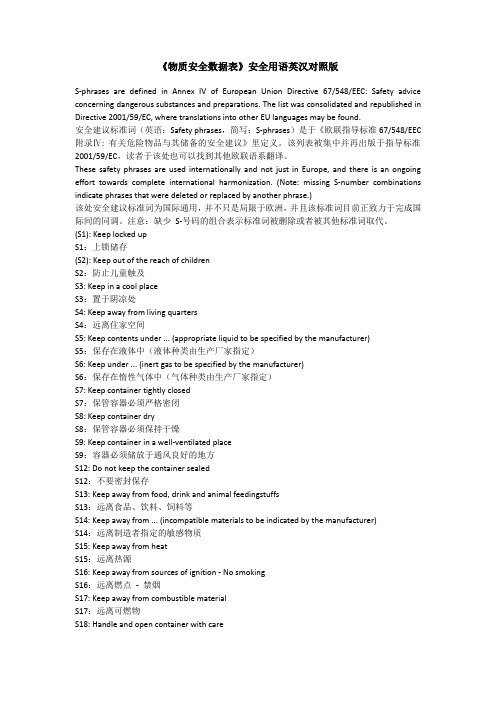
《物质安全数据表》安全用语英汉对照版S-phrases are defined in Annex IV of European Union Directive 67/548/EEC: Safety advice concerning dangerous substances and preparations. The list was consolidated and republished in Directive 2001/59/EC, where translations into other EU languages may be found.安全建议标准词(英语:Safety phrases,简写:S-phrases)是于《欧联指导标准67/548/EEC 附录Ⅳ: 有关危险物品与其储备的安全建议》里定义。
该列表被集中并再出版于指导标准2001/59/EC,读者于该处也可以找到其他欧联语系翻译。
These safety phrases are used internationally and not just in Europe, and there is an ongoing effort towards complete international harmonization. (Note: missing S-number combinations indicate phrases that were deleted or replaced by another phrase.)该处安全建议标准词为国际通用,并不只是局限于欧洲,并且该标准词目前正致力于完成国际间的同调。
注意:缺少S-号码的组合表示标准词被删除或者被其他标准词取代。
(S1): Keep locked upS1:上锁储存(S2): Keep out of the reach of childrenS2:防止儿童触及S3: Keep in a cool placeS3:置于阴凉处S4: Keep away from living quartersS4:远离住家空间S5: Keep contents under ... (appropriate liquid to be specified by the manufacturer)S5:保存在液体中(液体种类由生产厂家指定)S6: Keep under ... (inert gas to be specified by the manufacturer)S6:保存在惰性气体中(气体种类由生产厂家指定)S7: Keep container tightly closedS7:保管容器必须严格密闭S8: Keep container dryS8:保管容器必须保持干燥S9: Keep container in a well-ventilated placeS9:容器必须储放于通风良好的地方S12: Do not keep the container sealedS12:不要密封保存S13: Keep away from food, drink and animal feedingstuffsS13:远离食品、饮料、饲料等S14: Keep away from ... (incompatible materials to be indicated by the manufacturer)S14:远离制造者指定的敏感物质S15: Keep away from heatS15:远离热源S16: Keep away from sources of ignition - No smokingS16:远离燃点- 禁烟S17: Keep away from combustible materialS17:远离可燃物S18: Handle and open container with careS18:小心处理容器与开启容器S20: When using do not eat or drinkS20:使用中严禁饮食S21: When using do not smokeS21:使用中禁烟S22: Do not breathe dustS22:不要吸入微尘S23: Do not breathe gas/fumes/vapour/spray (appropriate wording to be specified by the manufacturer)S23:不要吸入瓦斯/毒气/蒸气/泡沫(合适用词由制造业者指定)S24: Avoid contact with skinS24:避免接触皮肤S25: Avoid contact with eyesS25:避免接触眼睛S26: In case of contact with eyes, rinse immediately with plenty of water and seek medical advice S26:接触眼睛后立即用大量清水冲洗并求医S27: Take off immediately all contaminated clothingS27:立即脱去被污染了的衣服S28: After contact with skin, wash immediately with plenty of ... (to be specified by the manufacturer)S28:接触皮肤后立即用大量液体冲洗(用来冲洗的液体由生产厂家指定)S29: Do not empty into drainsS29:禁止排入下水道S30: Never add water to this productS30:严禁向该制品加水S33: Take precautionary measures against static dischargesS33:预防静电S35: This material and its container must be disposed of in a safe wayS35:该物质及容器必须以安全安全方式处置S36: Wear suitable protective clothingS36:穿着适合的防护服S37: Wear suitable glovesS37:戴适合的手套S38: In case of insufficient ventilation wear suitable respiratory equipmentS38:通风不良时戴适合的呼吸装备S39: Wear eye/face protectionS39:戴适合的护脸护演装备S40: To clean the floor and all objects contaminated by this material use ... (to be specified by the manufacturer)S40:用清洁剂清洗被该物质污染过的地面和所有物品(清洁剂由生产厂家指定)S41: In case of fire and/or explosion do not breathe fumesS41:着火爆炸时不要吸入烟雾S42: During fumigation/spraying wear suitable respiratory equipment (appropriate wording to be specified by the manufacturer)S42:薰蒸或喷洒时佩带适合的呼吸装备S43: In case of fire use ... (indicate in the space the precise type of fire-fighting equipment. If water increases the risk add - Never use water)S43:着火时用指定物质灭火(如喷水增加危险性,请加注严禁用水)S45: In case of accident or if you feel unwell seek medical advice immediately (show the label where possible)S45:发生事故或感到不适时立即求医,可能的话出示标签S46: If swallowed, seek medical advice immediately and show this container or labelS46:如果误服请立即求医,可能的话出示容器或标签S47: Keep at temperature not exceeding ... °C (to be specified by the manufacturer)S47:保持温度不高于(生产厂家指定的温度)S48: Keep wet with ... (appropriate material to be specified by the manufacturer)S48:用指定物质保持湿润S49: Keep only in the original containerS49:限原容器储存S50: Do not mix with ... (to be specified by the manufacturer)S50:禁止与某些物质混合(所限物质由生产厂家指定)S51: Use only in well-ventilated areasS51:仅可于通风处使用S52: Not recommended for interior use on large surface areasS52:不推荐在表面积大的区域内部使用S53: Avoid exposure - obtain special instructions before useS53:防止暴露:使用前需获特别指导S56: Dispose of this material and its container at hazardous or special waste collection pointS56:在危险废物或有毒废物收集处处置该物质及容器S57: Use appropriate containment to avoid environmental contaminationS57:适当封存以免污染环境S59: Refer to manufacturer/supplier for information on recovery/recyclingS59:参考生产厂家/提供商所给信息进行回收/再利用S60: This material and its container must be disposed of as hazardous wasteS60:该物质及容器必须按危险废物放置S61: Avoid release to the environment. Refer to special instructions/safety data sheetS61:防止排向环境,参考特别指示或安全技术说明书操作S62: If swallowed, do not induce vomiting: seek medical advice immediately and show this container or labelS62:误服后不要催吐,要立即求医并出示容器或标签S63: In case of accident by inhalation: remove casualty to fresh air and keep at restS63:若意外吸入情况发生时,移动伤者至通风空气清新处并保持休息S64: If swallowed, rinse mouth with water (only if the person is conscious)S64:若不慎吞服并且患者仍清醒,用清水漱口Combinations组合(S1/2): Keep locked up and out of the reach of childrenS1/2:上锁储存并防止儿童触及S3/7: Keep container tightly closed in a cool placeS3/7:保管容器必须严格密闭并置于阴凉处S3/7/9: Keep container tightly closed in a cool, well-ventilated placeS3/7/9:保管容器必须严格密闭并置于阴凉、通风良好的地方S3/9/14: Keep in a cool, well-ventilated place away from ... (incompatible materials to be indicated by the manufacturer)S3/9/14:置于阴凉、通风良好的地方,并远离制造者指定的敏感物质S3/9/14/49: Keep only in the original container in a cool, well-ventilated place away from ... (incompatible materials to be indicated by the manufacturer)S3/9/14/49:限原容器储存,置于阴凉、通风良好的地方,并远离制造者指定的敏感物质S3/9/49: Keep only in the original container in a cool, well-ventilated placeS3/9/49:限原容器储存,置于阴凉、通风良好的地方S3/14 Keep in a cool place away from ... (incompatible materials to be indicated by the manufacturer)S3/14:置于阴凉处并远离制造者指定的敏感物质S7/8: Keep container tightly closed and dryS7/8:严格密闭,保持干燥S7/9: Keep container tightly closed and in a well-ventilated placeS7/9:严格密闭,保持通风S7/47: Keep container tightly closed and at temperature not exceeding ... °C (to be specified by the manufacturer)S7/47:保管容器必须严格密闭且保持温度不高于(生产厂家指定的温度)S20/21: When using do not eat, drink or smokeS20/21:使用中严禁饮食吸烟S24/25: Avoid contact with skin and eyesS24/25:防止接触皮肤与眼睛S27/28: After contact with skin, take off immediately all contaminated clothing, and wash immediately with plenty of ... (to be specified by the manufacturer)S27/28:接触皮肤后立即脱去被污染了的衣服并用大量液体冲洗(用来冲洗的液体由生产厂家指定)S29/35: Do not empty into drains; dispose of this material and its container in a safe wayS29/35:该物质及容器必须以安全方式处置并禁止排入下水道S29/56: Do not empty into drains, dispose of this material and its container at hazardous or special waste collection pointS29/56:在危险废物或有毒废物收集处处置该物质及容器,禁止排入下水道S36/37: Wear suitable protective clothing and glovesS36/37:请穿戴适当防护服装与手套处理本物质S36/37/39: Wear suitable protective clothing, gloves and eye/face protectionS36/37/39:穿戴适合的防护服、手套及护眼护脸装备S36/39: Wear suitable protective clothing and eye/face protectionS36/39:穿戴适合的防护服、护脸、护眼装备S37/39: Wear suitable gloves and eye/face protectionS37/39:穿戴适合的手套及护眼护脸装备S47/49: Keep only in the original container at temperature not exceeding ... °C (to be specified bythe manufacturer)S47/49:限原容器储存并保持温度不高于(生产厂家指定的温度)R-phrases (short for Risk Phrases) are defined in Annex III of European Union Directive 67/548/EEC: Nature of special risks attributed to dangerous substances and preparations. The list was consolidated and republished in Directive 2001/59/EC, where translations into other EU languages may be found.警示性质标准词(英语:Risk Phrases,简写:R-phrases)是于《欧联指导标准67/548/EEC 附录III: 有关危险物品与其储备的特殊风险性质》里定义。
安全词汇

国外安全成语●Safety is a commodity. 安全就是商品!●Safety at first 安全第一!●To be safe can not depend on wise behind. 安全不能指望事后诸葛!●Tolerating danger is to cut one's own throat. 容忍危险等于作法自毙!●Second thoughts are best for safety. 为了安全须三思而后行!●A stunble may prevent a fall. 小踬可防大跌!常见的安全英语名词现代安全管理(MSM)·工艺安全管理(PSM)·国际安全评级系统(ISRS)·HSE状况(HSE Case)·紧急预案(ERP)·危险源辨识(HAZID)·危害与可操作性分析(HAZOP)·工艺危险性分析(PHA)·如果-怎么办分析(What-if)·故障类型及影响分析(FMEA)·事件树分析(Event Tree Analysis)·故障树分析(Fault Tree Analysis)·定性风险评价(Qualitative Risk Assessment)·量化风险评价(QRA)·火灾安全性分析(Fire Safety Analysis)·安全审核(Safety Audit)·项目风险管理(Project Risk Management)·企业风险管理(Enterprise Risk Management)安全词汇英语翻译鄙人整理了一些安全方面的词汇资料,拿出来与大家共享,希望有所价值。
呵呵……MB Mining Bureau 矿业局Safe allawable floor load 楼板安全允许荷载Safe atmosphere 安全气氛Safe capacity 安全承载能力Safe circuit 安全电路Safe concentration 安全浓度Safe container 安全集装箱Safe criterion 安全准则Safe current carrying capacity 安全载流量Safe current 安全电流Safe curtain 防火幕Safe dispersing area 安全疏散面积Safe dust concentration 安全含尘浓度Safe escape appliance 安全逃生器具Safe escape/evacuation 安全疏散Safe floor 安全层Safe guard 安全措施Safe illumination 安全照明Safe in operation 安全操作Safe limit 安全界限Safe load 安全载荷Safe operating pressure 安全操作能力Safe practice 安全惯例Safe refuge 避难所Safe reliability 安全可靠性Safe temprature 安全湿度Safe guard consturction 安全结构Safeguard measure 保证措施Safeguard practice 保护性措施Safeguard sturcture 防护结构Safeguarding structure 防护构筑物Safelight box 安全灯箱Safety explosive 安全炸药Safety accessory 安全设备Safety accommodation 安全设备Safety alarm device 安全警报装置Safety alert symbol 安全惊叹号Safety appartatus 安全设备Safety approval plate 安全合格牌照Safety assembly 安全装置Safety belt/blasting 安全带Safety cap lamp 安全帽灯Safety check 止回阀Safety clothing 安全服Safety communications equipment 安全通讯设备Safetycontrol circuit 安全控制电路Safety control mark 安全控制标记Safety coupling 保险联接器Safety cut-off 安全开关Safety department 矿山安全部门Safety device 保安装置Safety director 安全员Safety disc 安全片Safety door latch 安全门锁Safety drift 安全水平巷道Safety earthing 保护接地Safety element 安全原件Safety engineering 安全工程学Safety equipment cabinet 安全设备箱Safety evacuation travel distance 安全疏散距离Safety exhaust 安全排气阀Safety face shield 安全面罩Safety factor 安全系数Safety flap 安全瓣Safety flask 安全瓶颈Safety fuel 安全燃料Safety fuse cutout = electric fuse 保险丝Safety fuse 安全导火线Safety fusible plug 易熔安全塞Safety gap 安全隙Safety garment 救生衣Safety gear 安全机构Safety glass 安全玻璃Safety goggles 防护眼镜Safety grounding 安全接地Safety guard 安全防护板Safety harness 安全带Safety hat 安全帽Safety hatch 安全出口Safety head lamp 安全头灯Safety head 安全盖Safety hook 安全钩Safety in Mine Research and Testing Branch 矿山安全研究试验所Safety in Mine Research Board 矿山安全研究委员会Safety in Mines Research Establishment 矿山安全研究院Safety ink 安全油墨Safety inspection 安全检查Safety inspector 安全检查员Safety installation 安全设备Safety instruction 安全说明Safety instrumentation 安全测试装置Safety interlayer 安全夹层Safety interlock 安全联锁装置Safety interlocking 安全联锁Safety island 安全岛Safety ladder 安全梯Safety lamp gauze 安全灯网罩Safety lamp 安全灯Safety legislation 安全法律Safety light 安全指示灯Safety lighting fitting 安全照明装置Safety lighting 安全照明Safety limit switch 保险总开关Safety load factor 安全荷载系数Safety load 安全荷载Safety lock 危险品储藏小室Safety margin 安全限度Safety marking 安全标志Safety match 安全火柴Safety measure 安全措施Safety method 安全办法Safety observation station 安全观察站Safety of life at sea 海上生命安全。
安全与风险术语中英文一览表
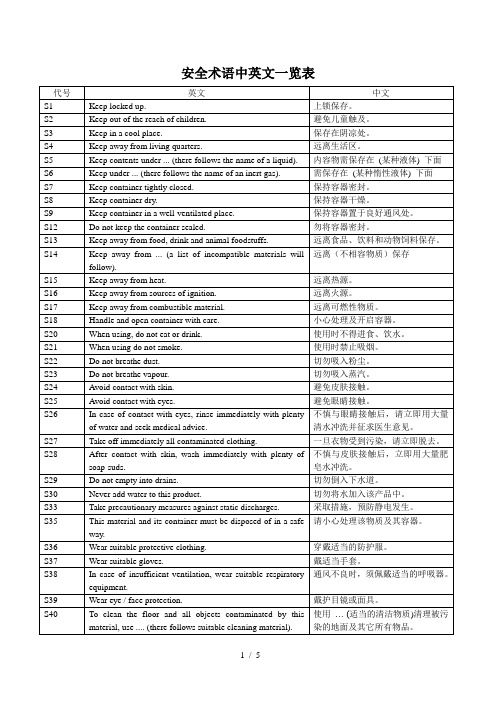
S27
Take off immediately all contaminated clothing.
一旦衣物受到污染,请立即脱去。
S28
After contact with skin, wash immediately with plenty of soap-suds.
避免接触,使用前须获得特别指示说明。
S56
Dispose of this material and its container at hazardous or special waste collection point.
在危险或特殊性废料收集点处置该物质及其容器。
S57
Use appropriate container to avoid environmental contamination.
熏蒸/喷洒时,须佩戴适当的呼吸器。
S43
In case of fire use ... (there follows the type of fire-fighting equipment to be used.)
一旦起火,用(灭火设备类型的)灭火。
S45
In case of accident or if you feel unwell, seek medical advice immediately (show the label whenever possible.)
该物质及其容器须作为危险性废料处置。
S61
Avoid release to the environment. Refer to special instructions / safety data sheets.
MSDS中英文版样本
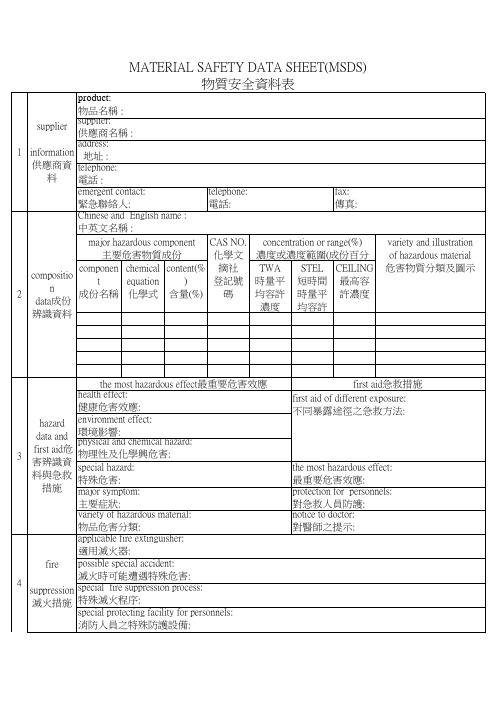
telephone: 電話:
fax: 傳真:
CAS NO. concentration or range(%) 化學文 濃度或濃度範圍(成份百分 TWA STEL CEILING 摘社 登記號 時量平 短時間 最高容 均容許 時量平 許濃度 碼 濃度 均容許
variety and illustration of hazardous material 危害物質分類及圖示
name: 姓名: month 月
ቤተ መጻሕፍቲ ባይዱ
date 日
engineering control: 工程控制: parameter control: 參數控制: protecting facility for individual : 個人防護設備: breath protecting: 呼吸防護: hand protectintg: 手部防護: cleanness measure: 衛生措施: substance state: 物質狀態: colour: 顏色: PH value: PH值: decomposing temperature: 分解溫度:
9
10
11
12
13
14
avoiding state: 應避免狀況: avoiding substance: 應避免之物質: harmful decomposed substance: 危害分解物: urgent toxicity: 急毒性: local effect: toxicity 局部效應: data毒性 slow or long toxicity: 資料 慢毒性或長期毒性: special effect: 特殊效應: entironment possible environment effect or spread: data生態 可能環境影響/環境流佈: 資料 abandoning method: disposal廢 廢棄處置方法: 棄處置方 法 international transport rule : 國際運送規定: UN's NO. : transport 聯合國編號: data運送 domestic transport rule: 資料 國內運送規定: special transport method and notice: 特殊運送方法及注意事項: applicable law: law data 適用法規: 法規資料 reference: 參考文獻: establishing department: 製表單位:
环境安全术语
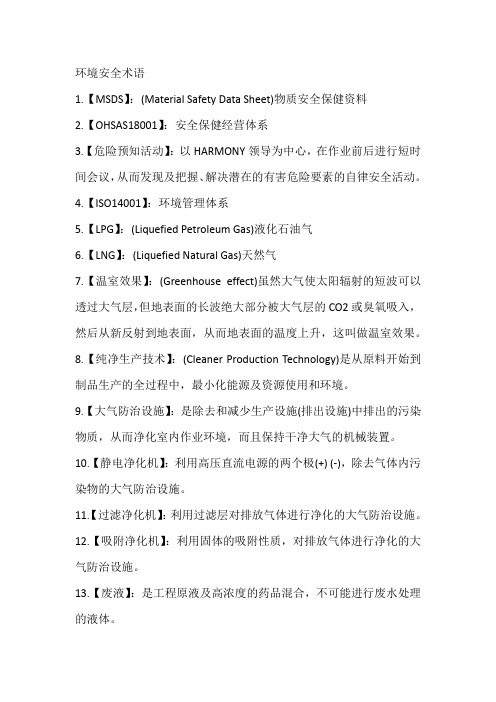
环境安全术语1.【MSDS】:(Material Safety Data Sheet)物质安全保健资料2.【OHSAS18001】:安全保健经营体系3.【危险预知活动】:以HARMONY领导为中心,在作业前后进行短时间会议,从而发现及把握、解决潜在的有害危险要素的自律安全活动。
4.【ISO14001】:环境管理体系5.【LPG】:(Liquefied Petroleum Gas)液化石油气6.【LNG】:(Liquefied Natural Gas)天然气7.【温室效果】:(Greenhouse effect)虽然大气使太阳辐射的短波可以透过大气层,但地表面的长波绝大部分被大气层的CO2或臭氧吸入,然后从新反射到地表面,从而地表面的温度上升,这叫做温室效果。
8.【纯净生产技术】:(Cleaner Production Technology)是从原料开始到制品生产的全过程中,最小化能源及资源使用和环境。
9.【大气防治设施】:是除去和减少生产设施(排出设施)中排出的污染物质,从而净化室内作业环境,而且保持干净大气的机械装置。
10.【静电净化机】:利用高压直流电源的两个极(+) (-),除去气体内污染物的大气防治设施。
11.【过滤净化机】:利用过滤层对排放气体进行净化的大气防治设施。
12.【吸附净化机】:利用固体的吸附性质,对排放气体进行净化的大气防治设施。
13.【废液】:是工程原液及高浓度的药品混合,不可能进行废水处理的液体。
14.【废水】:生产过程中产生的,能够废水处理的工业废水。
15.【非常联络网】:公司发生紧急事态时,利用非常联络网进行对应并报告,以减少因灾害造成的损失。
16.【保护用具】:是为预防产业灾害,在作业这身体的一部分或全部佩带各种保护用具。
17.【ABC干粉灭火器】:能灭普通火灾(A级),可燃气体,液体火灾(B 级),电气火灾(C级)的灭火器。
18.【逃生设施】:发生火灾时,能够利用其逃生的设备(逃生袋,缓降器,气垫,呼吸器)。
(安全生产)安全警示英文大全

(安全生产)安全警示英文大全安全警示:当心坠落——becarefulfalling严禁烟火——nofire安全出口——exit非工作人员禁止入内——personnelonly必须戴护耳器——becarefulnoise必须戴防护口罩——respiratormustbeworn谢绝参观——novisit严禁拍照——nophotos防止碰撞——becarefulhiting非专业人员禁止操作——operatingbyprofessionalonly 当心有毒——becarefulvenomousness必须戴防毒面具——gasmaskmustbeworn仓库重地闲人免进——storehouse,noadmittance吊装区域禁止停留——sling,nostop机房重地闲人免进——computerroom,noadmittance高压危险——becarefulhighvoltage禁止入内——noentry禁止合闸——don’toperateabrake小心有电——becarefulelectricity运转设备——operatingequipment备用设备——standbyequipment当心电离辐射——becarefulionization上方有蒸汽排气管此处禁止停留——vent-pipe,nostop ================================================= X公司企业部门:总X公司HeadOffice分X公司BranchOffice营业部BusinessOffice人事部PersonnelDepartment(人力资源部)HumanResourcesDepartment总务部GeneralAffairsDepartment财务部GeneralAccountingDepartment销售部SalesDepartment促销部SalesPromotionDepartment国际部InternationalDepartment出口部ExportDepartment进口部ImportDepartment公共关系PublicRelationsDepartment广告部AdvertisingDepartment企划部PlanningDepartment产品开发部ProductDevelopmentDepartment研发部ResearchandDevelopmentDepartment(R&D)秘书室SecretarialPool===============================================公共标志:1、BusinessHours营业时间2、OfficeHours办公时间3、Entrance入口4、Exit出口5、Push推6、Pull拉7、Shut此路不通8、On打开(放)9、Off关10、Open营业(注:多用于商店等营业场所)11、Pause暂停12、Stop关闭13、Closed下班、打烊(注:同10)14、Menu菜单15、Fragile易碎16、ThisSideUp此面向上17、Introductions说明18、OneStreet单行道19、KeepRight/Left靠左/右20、BusesOnly只准公共汽车通过21、WetPaint油漆未干22、Danger危险23、LostandFound失物招领处24、GiveWay快车先行25、SafetyFirst安全第壹26、FillingStation加油站27、NoSmoking禁止吸烟28、NoPhotos请勿拍照29、NoVisitors游人止步30、NoEntry禁止入内31、NoAdmittance闲人免进32、NoHonking禁止鸣喇叭33、Parking停车处34、TollFree免费通行35、F.F.快进(注:FastForward)36、Rew.倒带(注:Re-Wind)37、EMS(邮政)特快专递38、InsertHere此处插入39、OpenHere此处开启40、SplitHere此处撕开41、MechanicalHelp车辆修理42、“AA”Film十四岁以下禁见电影43、DoNotPass禁止超车44、NoU-Turn禁止掉头45、U-TurnOk能够U形转弯46、NoCyclingintheSchool校内禁止骑车47、SOS紧急求救信号48、HandsWanted招聘49、StaffOnly本处职工专用50、NoLitter勿乱扔杂物51、HandsOff请勿用手摸52、KeepSilence保持安静53、OnSale削价出售、打折54、NoBills不准张贴55、NotforSale恕不出售56、Pub酒馆57、Cafe咖啡馆、小餐馆58、Bar酒巴59、Laundry洗衣店60、TravelAgency旅行社61、InShade置于阴凉处62、KeepinDarkPlace避光保存63、Poison有毒/毒品64、GuardagainstDamp防潮65、BewareofPickpocket谨防扒手66、ComplaintBox意见箱67、ForUseOnlyinCaseofFire灭火专用68、Bakery面包店69、KeepDry保持干燥70、Information问讯处71、NoPassing禁止通行72、NoAngling不准垂钓73、ShootingProhibited禁止打猎74、SeatbyNumber对号入座75、ProtectPublicPropety爱护公共财物76、TicketOffice(or:BookingOffice)售票处77、VisitorsPleaseRegister来宾登记78、WipeYourShoesAndBoots请擦去鞋上的泥土79、Men's/Gentlemen/GentsRoom男厕所80、Women's/Ladies/Ladies'Room女厕所81、Occupied(厕所)有人82、Vacant(厕所)无人83、CommitNoNuisance禁止小便84、Net(Weight)净重85、MAN:25032002生产日期:2002年3月25日86、EXP:25032002失效期:2002年3月25日87、AdmissionFree免费入场88、BikePark(ing)自行车存车处89、ChildrenandWomenFirst妇女、儿童优先90、SaveFood节约粮食91、SaveEnergy节约能源92、HandlewithCare小心轻放93、DogsNotAllowed禁止携犬入内94、KeepAwayFromFire切勿近火95、ReducedSpeedNow减速行驶96、RoadUp.Detour马路施工,请绕行97、KeepTopSideUp请勿倒立98、TakeCareNottoLeaveThingsBehind当心不要丢失东西99、PleaseReturntheBackAfterUse用毕放回架上100、LuggageDepository行李存放处禁止穿化纤服Noputtingonchemicalfibreclothing禁戴手套Noputtingongloves禁止穿带钉鞋Noputtingonspikes禁止乘人Noriding禁止启动Nostarting禁止跨越Nostriding禁止合闸Noswitchingon禁止抛物Notossing禁止用水灭火Nowateringtoputoutthefire鉴于治安考虑,请您随时保持警惕,将您的包袋、个人物品随身携带。
物资安全资料表翻译
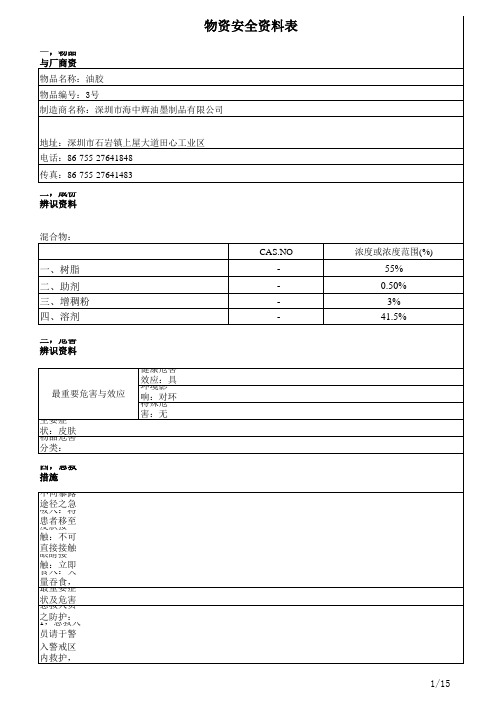
The most important hazards and effects
Environmental impact: hazard to the environment, can cause water and ai Special hazards:None
The main symptoms: skin irritation, respiratory tract if swallowed corrosive and tingling. Hazard Category:
三,危害辨识资料
-
55% 0.50% 3% 41.5%
健康危害效应:具皮肤刺激性,呼吸道刺激性 最重要危害与效应 环境影响:对环境有危害,对水体和大气可造成污染。 特殊危害:无 主要症状:皮肤刺激,呼吸道吞食产生腐蚀与刺痛。 物品危害分类: 四,急救措施 不同暴露途径之急救方法: 吸入:将患者移至新鲜空气处,并尽速送医。 皮肤接触:不可直接接触皮肤,如不慎接触,请即时以肥皂水清洗,并反复用清水冲洗干净。 眼睛接触:立即以大量清水冲洗,并送医。 食入:大量吞食,立即送医,不可使患者呕吐。 最重要症状及危害效应:对皮肤具有刺激性与腐蚀性。 急救人员之防护: 1,急救人员请于警戒区外施行紧急救护。 2,如须进入警戒区内救护,请依第8项暴露预防措施中个人防护设备指示,穿着适当防护设备。
8,Exposure precautions
Engineering Controls: system.2, the exhaust appropriate measures. 4, Provide sufficient Control parameters:
Chinese/English name Eight - hour day Average allowable concentration Short-Term Average allowable concentration
- 1、下载文档前请自行甄别文档内容的完整性,平台不提供额外的编辑、内容补充、找答案等附加服务。
- 2、"仅部分预览"的文档,不可在线预览部分如存在完整性等问题,可反馈申请退款(可完整预览的文档不适用该条件!)。
- 3、如文档侵犯您的权益,请联系客服反馈,我们会尽快为您处理(人工客服工作时间:9:00-18:30)。
《物质安全数据表》安全用语英汉对照版S-phrases are defined in Annex IV of European Union Directive 67/548/EEC: Safety advice concerning dangerous substances and preparations. The list was consolidated and republished in Directive 2001/59/EC, where translations into other EU languages may be found.安全建议标准词(英语:Safety phrases,简写:S-phrases)是于《欧联指导标准67/548/EEC 附录Ⅳ: 有关危险物品与其储备的安全建议》里定义。
该列表被集中并再出版于指导标准2001/59/EC,读者于该处也可以找到其他欧联语系翻译。
These safety phrases are used internationally and not just in Europe, and there is an ongoing effort towards complete international harmonization. (Note: missing S-number combinations indicate phrases that were deleted or replaced by another phrase.)该处安全建议标准词为国际通用,并不只是局限于欧洲,并且该标准词目前正致力于完成国际间的同调。
注意:缺少S-号码的组合表示标准词被删除或者被其他标准词取代。
(S1): Keep locked upS1:上锁储存(S2): Keep out of the reach of childrenS2:防止儿童触及S3: Keep in a cool placeS3:置于阴凉处S4: Keep away from living quartersS4:远离住家空间S5: Keep contents under ... (appropriate liquid to be specified by the manufacturer)S5:保存在液体中(液体种类由生产厂家指定)S6: Keep under ... (inert gas to be specified by the manufacturer)S6:保存在惰性气体中(气体种类由生产厂家指定)S7: Keep container tightly closedS7:保管容器必须严格密闭S8: Keep container dryS8:保管容器必须保持干燥S9: Keep container in a well-ventilated placeS9:容器必须储放于通风良好的地方S12: Do not keep the container sealedS12:不要密封保存S13: Keep away from food, drink and animal feedingstuffsS13:远离食品、饮料、饲料等S14: Keep away from ... (incompatible materials to be indicated by the manufacturer)S14:远离制造者指定的敏感物质S15: Keep away from heatS15:远离热源S16: Keep away from sources of ignition - No smokingS16:远离燃点- 禁烟S17: Keep away from combustible materialS17:远离可燃物S18: Handle and open container with careS18:小心处理容器与开启容器S20: When using do not eat or drinkS20:使用中严禁饮食S21: When using do not smokeS21:使用中禁烟S22: Do not breathe dustS22:不要吸入微尘S23: Do not breathe gas/fumes/vapour/spray (appropriate wording to be specified by the manufacturer)S23:不要吸入瓦斯/毒气/蒸气/泡沫(合适用词由制造业者指定)S24: Avoid contact with skinS24:避免接触皮肤S25: Avoid contact with eyesS25:避免接触眼睛S26: In case of contact with eyes, rinse immediately with plenty of water and seek medical advice S26:接触眼睛后立即用大量清水冲洗并求医S27: Take off immediately all contaminated clothingS27:立即脱去被污染了的衣服S28: After contact with skin, wash immediately with plenty of ... (to be specified by the manufacturer)S28:接触皮肤后立即用大量液体冲洗(用来冲洗的液体由生产厂家指定)S29: Do not empty into drainsS29:禁止排入下水道S30: Never add water to this productS30:严禁向该制品加水S33: Take precautionary measures against static dischargesS33:预防静电S35: This material and its container must be disposed of in a safe wayS35:该物质及容器必须以安全安全方式处置S36: Wear suitable protective clothingS36:穿着适合的防护服S37: Wear suitable glovesS37:戴适合的手套S38: In case of insufficient ventilation wear suitable respiratory equipmentS38:通风不良时戴适合的呼吸装备S39: Wear eye/face protectionS39:戴适合的护脸护演装备S40: To clean the floor and all objects contaminated by this material use ... (to be specified by the manufacturer)S40:用清洁剂清洗被该物质污染过的地面和所有物品(清洁剂由生产厂家指定)S41: In case of fire and/or explosion do not breathe fumesS41:着火爆炸时不要吸入烟雾S42: During fumigation/spraying wear suitable respiratory equipment (appropriate wording to be specified by the manufacturer)S42:薰蒸或喷洒时佩带适合的呼吸装备S43: In case of fire use ... (indicate in the space the precise type of fire-fighting equipment. If water increases the risk add - Never use water)S43:着火时用指定物质灭火(如喷水增加危险性,请加注严禁用水)S45: In case of accident or if you feel unwell seek medical advice immediately (show the label where possible)S45:发生事故或感到不适时立即求医,可能的话出示标签S46: If swallowed, seek medical advice immediately and show this container or labelS46:如果误服请立即求医,可能的话出示容器或标签S47: Keep at temperature not exceeding ... °C (to be specified by the manufacturer)S47:保持温度不高于(生产厂家指定的温度)S48: Keep wet with ... (appropriate material to be specified by the manufacturer)S48:用指定物质保持湿润S49: Keep only in the original containerS49:限原容器储存S50: Do not mix with ... (to be specified by the manufacturer)S50:禁止与某些物质混合(所限物质由生产厂家指定)S51: Use only in well-ventilated areasS51:仅可于通风处使用S52: Not recommended for interior use on large surface areasS52:不推荐在表面积大的区域内部使用S53: Avoid exposure - obtain special instructions before useS53:防止暴露:使用前需获特别指导S56: Dispose of this material and its container at hazardous or special waste collection pointS56:在危险废物或有毒废物收集处处置该物质及容器S57: Use appropriate containment to avoid environmental contaminationS57:适当封存以免污染环境S59: Refer to manufacturer/supplier for information on recovery/recyclingS59:参考生产厂家/提供商所给信息进行回收/再利用S60: This material and its container must be disposed of as hazardous wasteS60:该物质及容器必须按危险废物放置S61: Avoid release to the environment. Refer to special instructions/safety data sheetS61:防止排向环境,参考特别指示或安全技术说明书操作S62: If swallowed, do not induce vomiting: seek medical advice immediately and show this container or labelS62:误服后不要催吐,要立即求医并出示容器或标签S63: In case of accident by inhalation: remove casualty to fresh air and keep at restS63:若意外吸入情况发生时,移动伤者至通风空气清新处并保持休息S64: If swallowed, rinse mouth with water (only if the person is conscious)S64:若不慎吞服并且患者仍清醒,用清水漱口Combinations组合(S1/2): Keep locked up and out of the reach of childrenS1/2:上锁储存并防止儿童触及S3/7: Keep container tightly closed in a cool placeS3/7:保管容器必须严格密闭并置于阴凉处S3/7/9: Keep container tightly closed in a cool, well-ventilated placeS3/7/9:保管容器必须严格密闭并置于阴凉、通风良好的地方S3/9/14: Keep in a cool, well-ventilated place away from ... (incompatible materials to be indicated by the manufacturer)S3/9/14:置于阴凉、通风良好的地方,并远离制造者指定的敏感物质S3/9/14/49: Keep only in the original container in a cool, well-ventilated place away from ... (incompatible materials to be indicated by the manufacturer)S3/9/14/49:限原容器储存,置于阴凉、通风良好的地方,并远离制造者指定的敏感物质S3/9/49: Keep only in the original container in a cool, well-ventilated placeS3/9/49:限原容器储存,置于阴凉、通风良好的地方S3/14 Keep in a cool place away from ... (incompatible materials to be indicated by the manufacturer)S3/14:置于阴凉处并远离制造者指定的敏感物质S7/8: Keep container tightly closed and dryS7/8:严格密闭,保持干燥S7/9: Keep container tightly closed and in a well-ventilated placeS7/9:严格密闭,保持通风S7/47: Keep container tightly closed and at temperature not exceeding ... °C (to be specified by the manufacturer)S7/47:保管容器必须严格密闭且保持温度不高于(生产厂家指定的温度)S20/21: When using do not eat, drink or smokeS20/21:使用中严禁饮食吸烟S24/25: Avoid contact with skin and eyesS24/25:防止接触皮肤与眼睛S27/28: After contact with skin, take off immediately all contaminated clothing, and wash immediately with plenty of ... (to be specified by the manufacturer)S27/28:接触皮肤后立即脱去被污染了的衣服并用大量液体冲洗(用来冲洗的液体由生产厂家指定)S29/35: Do not empty into drains; dispose of this material and its container in a safe wayS29/35:该物质及容器必须以安全方式处置并禁止排入下水道S29/56: Do not empty into drains, dispose of this material and its container at hazardous or special waste collection pointS29/56:在危险废物或有毒废物收集处处置该物质及容器,禁止排入下水道S36/37: Wear suitable protective clothing and glovesS36/37:请穿戴适当防护服装与手套处理本物质S36/37/39: Wear suitable protective clothing, gloves and eye/face protectionS36/37/39:穿戴适合的防护服、手套及护眼护脸装备S36/39: Wear suitable protective clothing and eye/face protectionS36/39:穿戴适合的防护服、护脸、护眼装备S37/39: Wear suitable gloves and eye/face protectionS37/39:穿戴适合的手套及护眼护脸装备S47/49: Keep only in the original container at temperature not exceeding ... °C (to be specified bythe manufacturer)S47/49:限原容器储存并保持温度不高于(生产厂家指定的温度)R-phrases (short for Risk Phrases) are defined in Annex III of European Union Directive 67/548/EEC: Nature of special risks attributed to dangerous substances and preparations. The list was consolidated and republished in Directive 2001/59/EC, where translations into other EU languages may be found.警示性质标准词(英语:Risk Phrases,简写:R-phrases)是于《欧联指导标准67/548/EEC 附录III: 有关危险物品与其储备的特殊风险性质》里定义。
